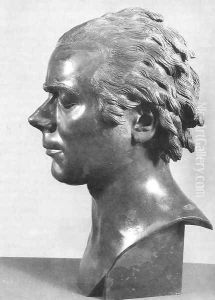Franz Xaver Messerschmidt Paintings
Franz Xaver Messerschmidt was a German-Austrian sculptor most renowned for his character heads, a collection of busts with bizarre and distorted expressions. Born on February 6, 1736, in Wiesensteig, Bavaria (then part of the Holy Roman Empire), Messerschmidt grew up in a family with a strong background in sculpture, which paved the way for his future career. He showed an early talent in the art, prompting his move to Vienna, where he furthered his studies and honed his skills under the guidance of his uncle, Johann Baptist Straub, a prominent sculptor, before enrolling at the Academy of Fine Arts Vienna.
Throughout the early stages of his career, Messerschmidt was highly regarded for his more traditional works, including portraits and classical figures, which adhered to the aesthetic norms of the time. His talent and skill earned him a position at the University of Vienna as a professor of sculpture, a role that seemed to promise a distinguished career in the academic and artistic circles of Vienna. However, Messerschmidt's life took a dramatic turn around the mid-1770s when he began to exhibit signs of psychological distress, which significantly impacted his work and social relations.
The most notable and enduring legacy of Franz Xaver Messerschmidt is his series of character heads. Created later in his life, from around 1770 until his death in 1783, these busts broke away radically from the neoclassical style prevalent at the time. Instead, they delved into the exploration of human expressions and emotions, ranging from anger and despair to mockery and astonishment. Made primarily in alabaster or metal, these heads are believed to reflect not only Messerschmidt's interest in physiognomy and the pseudo-science of the time, which sought to link facial expressions with the soul, but also his own inner turmoil and possible mental health struggles.
Messerschmidt's innovative approach to these sculptures, coupled with their technical brilliance, was both ahead of his time and misunderstood by his contemporaries, leading to his professional isolation. After being denied a promotion at the University of Vienna, supposedly because of his increasingly eccentric behavior and the unconventional nature of his work, he moved to Pressburg (now Bratislava, Slovakia) where he lived and worked in relative obscurity until his death on August 19, 1783. Despite his tragic end, Franz Xaver Messerschmidt's character heads have posthumously earned him recognition as a significant figure in the history of art, offering profound insights into the human condition and the complexities of mental health.


